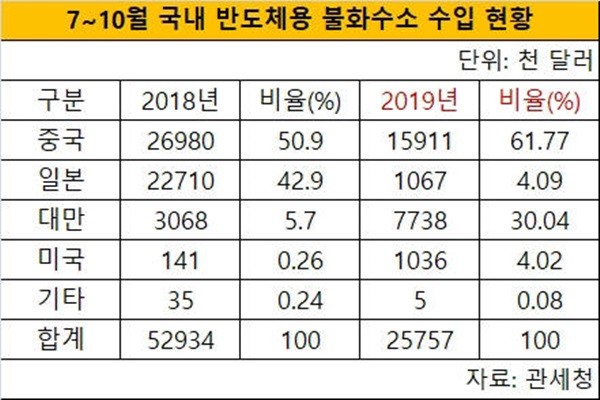South Korea’s hydrogen fluoride import market has changed drastically since Japanese Government has implemented semiconductor material export restrictions. While the amount of hydrogen fluoride imported from Japan has reduced rapidly, the amount of hydrogen fluoride imported from China has increased significantly. China is able to produce high-purity hydrogen fluoride as it is able to actively produce anhydrous hydrofluoric acid, which is one of raw materials of hydrogen fluoride. As a result, some predict that Chinese companies will be able to gain the leadership within the semiconductor material market over Japanese companies. South Korean semiconductor companies such as Samsung Electronics and SK Hynix are making various efforts to diversify suppliers of semiconductor materials while increasing the amount of collaboration with South Korean semiconductor material manufacturers.
According to materials from Korea Customs Service, the percentage of hydrogen fluoride imported from China increased greatly from July to October.
Between July and October, $25.76 million worth of hydrogen fluoride for the purpose of manufacturing semiconductors were imported. $15.91 worth of hydrogen fluoride had come from China taking up 60%.
Even before July, South Korean companies had been importing significant portion of hydrogen fluoride for the purpose of manufacturing semiconductor from China. Between July and October of last year, 50.9% of entire amount ($52.93 million) of hydrogen fluoride imported had come from China.
On the other hand, the percentage of hydrogen fluoride imported from Japan decreased sharply from 42% to 4%. As South Korean semiconductor companies have had a tough time importing hydrogen fluoride from Stellachemifa and Morita Chemical due to Japan’s semiconductor material export restrictions, Chinese companies have benefited. After Japan’s export restrictions were enforced, industries were mentioning some of Chinese chemical companies as potential replacements for hydrogen fluoride.
Some within the industry are saying that Chinese companies that have now seized the leadership of key semiconductor raw materials cannot be overlooked as well even though South Korean semiconductor companies have somewhat withstood against Japan’s export restrictions by replacing Japanese suppliers with Chinese suppliers.

China is the world’s biggest anhydrous hydrofluoric acid and low-purity liquified hydrogen fluoride in the world. Anhydrous hydrofluoric acid, which is produced by reacting fluorite and sulfuric acid, is extremely poisonous. Because China is less restricted compared to other countries when it comes to environment regulations, it actively produces anhydrous hydrofluoric acid. This is the reason why China that has the leadership in the production of raw materials can be a bigger threat to South Korea’s semiconductor industry unlike Japan that imports and refines raw materials.
“Although South Korean semiconductor companies have been able to lessen their dependence, Japan’s export restrictions have become an opportunity for Chinese companies to realize their strength and possible impact that they can have on the semiconductor market.” said a high-ranking official from a semiconductor material manufacturer. “Japan’s export restrictions have ultimately resulted in South Korean semiconductor companies depending on China.” This high-ranking official also added that Chinese companies also possess a technology to produce high-purity hydrogen fluoride.
Meanwhile, the percentages of hydrogen fluoride imported from Taiwan and the U.S. also increased. Although Chinese and Japanese companies had owned more than 90% of the hydrogen fluoride market in South Korea, South Korean semiconductor companies have been filling shortages by utilizing suppliers from various countries.
While the percentage of hydrogen fluoride imported from Taiwan between July and October of 2018 was only 5.7%, the percentage increased to 30% this year as $7.74 worth of hydrogen fluoride was imported from Taiwan between July and October. The amount of hydrogen fluoride imported from the U.S. between July and October of 2018 also jumped up a ten fold to $1.03 million this year.
There have been active cases of collaboration between South Korean semiconductor material manufacturers and South Korean semiconductor companies since the third quarter. Hydrogen fluoride manufacturers such as SoulBrain, ENF Technology, and RAM Technology have been working with semiconductor companies and they are expected to fill shortages of hydrogen fluoride.
Staff Reporter Kang, Hyeryung | kang@etnews.com